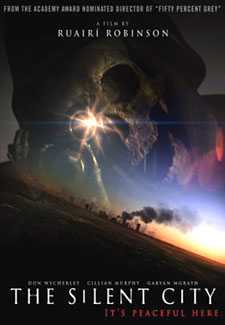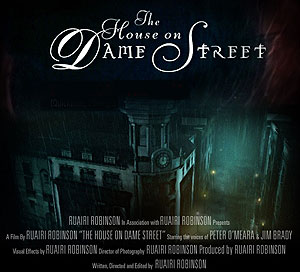 3D computer animator, compositor, storyboardist & short film director, Irishman Ruairi Robinson is, as I write this, transitioning into live-action feature film direction.
3D computer animator, compositor, storyboardist & short film director, Irishman Ruairi Robinson is, as I write this, transitioning into live-action feature film direction.
He's made many commercials for television, many of them high profile, plus a few animated short films of his own, & opening credit sequences for feature films.
You may have wondered why so many films are very slick & professional with skillful soundscape for the prelude & opening credits, then turn to crap. It's because very commonly, almost as a rule, vastly more talented people are hired anonymousy to do opening credit squences. Ruairi has been one of those guys.
A five-minute animation based as the credits say "Very very very very very loosely on The Case of Charles Dexter Ward by H. P. Lovecraft," The House on Dame Street (2000) is wickedly, weirdly designed. Even the color scheme is bizarre, evoking a dank world of runny stains.
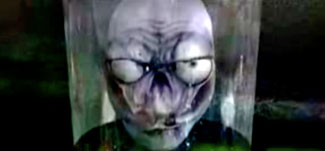 All too many Lovecraft microfilms resort to the "narrator" rather than permitting the pictorial matter to tell a tale, & this one follows that pattern. All too many Lovecraft microfilms resort to the "narrator" rather than permitting the pictorial matter to tell a tale, & this one follows that pattern.
Like the strangely smeared colors of the nighted rainy street, however, the voice of the narration is unreal, blending with the sound of the storm, very moody, & just a little spoofy of more commonplace lovecraftian micro-movies.
The jest established, momentarily the narration leaves off, & the rest does allow the visual content speak for itself.
We watch the solitary figure as he wanders the rain-drenched lamplit street of buildings closed tight with no signs of habitation. He finds his way into one of the old buildings through a narrow basement window.
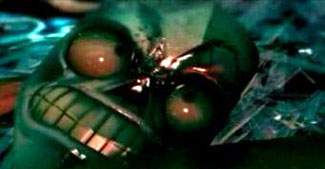 In a weird laboratory, he finds a head in a large display bottle. The head is alive & in horror he tosses the bottle on the floor, shattering it, then has to hack up the ferocious head. In a weird laboratory, he finds a head in a large display bottle. The head is alive & in horror he tosses the bottle on the floor, shattering it, then has to hack up the ferocious head.
He explores onward to the inexplicable sound of wailing hounds. He finds a manhole cover with a label or address upon it, "234, Jim Brady," & opens the lid. The significance of the name Jim Brady is not significant, but that really is the name of the actor doing the voice for the creature who pops out of the hole.
A horrible, living, coughing skeleton climbs out & asks angrily, "Where the fuck you been the last four fuckin' years you cunt? I tell ya, this place'll be the death of me."
It has gone that swiftly from atmospheric horror to grotesquely comical, not that it makes a lick of sense. The skeletal being & the gentleman who let him out of the unusual crypt seem to have a plan, but it is foiled when a tiny disgusting man appears & shoots our point of view character in the head, afterward sealing him in the manhole-covered pit.
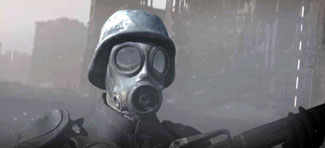 Ruairi Robinson has said of The House on Dame Street that he made in for his college degree, & set it in "a world of pure chaos."
Ruairi Robinson has said of The House on Dame Street that he made in for his college degree, & set it in "a world of pure chaos."
It could well be, more or less, the same world as we encounter in his seven-minute live-action film The Silent City (2006), except in the aftermath of catastrophic warfare.
This was his first excursion into live-action instead of animation, though it does also incorporate plenty of computer animation to create a credible three-domensional city in ruins.
A soldier in gas mask wandering the grey grim city looks up & is blown to shreds, collapsing without a head. We don't know what got him. We then cut to other soldiers holed up in a ruin on a rubble-strewn & war-torn landscape. These are excellent actors; one of them is Cillian Murphy.
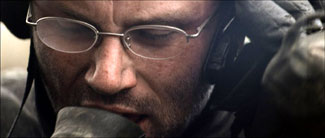 The coast is clear so they take off on a tramp through the ruins at the city's edge. Spotting a sniper in a tower, they take evasive action. The coast is clear so they take off on a tramp through the ruins at the city's edge. Spotting a sniper in a tower, they take evasive action.
One of the men triggers an explosive booby trap. Two of the men are badly injured, not apt to survive. The one uninjured discovers that the "sniper" is already long dead in his tower, no threat at all.
He gets on the radio & calls hysterically for assistance that wiill never come. The camera then zooms through the destruction of the city, where seemingly no life remains. We see again the headless corpse, with radio receiver near his dead hand picking up the call for help. Someone, or more likely something, hears the coordinates & takes off with supernatural speed toward that location.
Superbly done visual effects & well acted, made with funds from the Irish Film Board, The Silent City has the feeling of a "sample film" that might be used to get commercial work on action or s-f movies; or a fragment of a longer work the creative team had hoped would induce further funding for a feature length version.
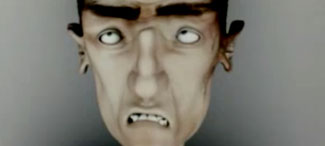 Robinson first gained international attention with a three-minute animated film Fifty Percent Grey (2001) which garnered him an Academy Award nomination.
Robinson first gained international attention with a three-minute animated film Fifty Percent Grey (2001) which garnered him an Academy Award nomination.
A soldier awakens on a nearly empty landscape. A widescreen television is nearby, & a brief tape welcomes him to the afterlife, promising him "all the time in the world" to enjoy the many pleasures. Only there is nothing anywhere to be seen.
He walks across the empty plain, finding nothing, until he encounters another television screen, older square model. He draws his gun, shoots himself in the head, & despite the hole from temple to temple, he's otherwise all right.
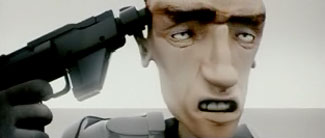 The television runs its short tape welcoming him to purgatory, where he remains, mostly likely, for having done something wrong in life, & must await judgement. The television runs its short tape welcoming him to purgatory, where he remains, mostly likely, for having done something wrong in life, & must await judgement.
He puts his gun in his mouth & tries again to end this. The back of his head is blown off, but he's otherwise fine. So he shoots the television. The end.
This one I must admit failed to impress me. Why did the widescreen television welcome him to heaven when he wasn't in heaven? Why did only the second older tv tell him it was purgatory?
The stiff computer animation certainly shows some slight relationship to the finer animation completed a year earlier for The House on Dame Street, but for Fifty Percent Grey, despite its Oscar nomination, the animation is clumsier & less compete.
Continue to another example of lovecraftian animation:
The Other Gods (2006)
copyright © by Paghat the Ratgirl
|
